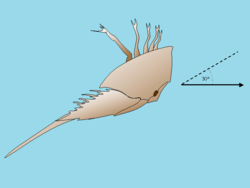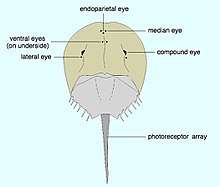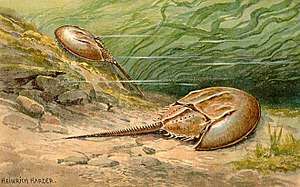Horseshoe crab
Horseshoe crabs are marine and brackish water arthropods of the family Limulidae, suborder Xiphosurida, and order Xiphosura.[3] Their popular name is a misnomer, as they are not crustaceans, which true crabs are.
| Limulidae | |
|---|---|
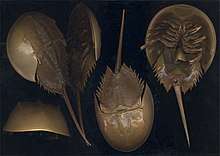 | |
| Limulus polyphemus | |
| Scientific classification | |
| Kingdom: | Animalia |
| Phylum: | Arthropoda |
| Subphylum: | Chelicerata |
| Order: | Xiphosura |
| Suborder: | Xiphosurida |
| Family: | Limulidae Leach, 1819 [2] |
| Genera | |
Horseshoe crabs live primarily in and around shallow coastal waters on soft sandy or muddy bottoms. They tend to spawn in the intertidal zone at spring high tides.[4] They are commonly eaten in Asia, and used as fishing bait, in fertilizer and in science (especially Limulus amebocyte lysate). In recent years, population declines have occurred as a consequence of coastal habitat destruction and overharvesting.[3] Tetrodotoxin may be present in one horseshoe crab species, Carcinoscorpius rotundicauda.[5]
Given their origin 450 million years ago, horseshoe crabs are considered living fossils.[6] A 2019 molecular analysis places them as the sister group of Ricinulei within Arachnida.[7]
Taxonomy
Horseshoe crabs resemble crustaceans but belong to a separate subphylum of the arthropods, Chelicerata.[8] Horseshoe crabs are closely related to the extinct eurypterids (sea scorpions), which include some of the largest arthropods to have ever existed, and the two may be sister groups.[8][9] Other studies have placed eurypterids closer to the arachnids in a group called Metastomata.[10] The enigmatic Chasmataspidids are also thought to be closely related to the horseshoe crabs.[11] The earliest horseshoe crab fossils are found in strata from the late Ordovician period, roughly 450 million years ago.
The Limulidae are the only recent family of the order Xiphosura, and contains all four living species of horseshoe crabs:[2][3]
- Carcinoscorpius rotundicauda, the mangrove horseshoe crab, found in South and Southeast Asia
- Limulus polyphemus, the Atlantic or American horseshoe crab, found along the American Atlantic coast and in the Gulf of Mexico
- Tachypleus gigas, the Indo-Pacific, Indonesian, Indian or southern horseshoe crab, found in South and Southeast Asia
- Tachypleus tridentatus, the Chinese, Japanese or tri-spine horseshoe crab, found in Southeast and East Asia
Anatomy and behavior
The entire body of the horseshoe crab is protected by a hard carapace. It has two compound lateral eyes, each composed of about 1,000 ommatidia, plus a pair of median eyes that are able to detect both visible light and ultraviolet light, a single endoparietal eye, and a pair of rudimentary lateral eyes on the top. The latter become functional just before the embryo hatches. Also, a pair of ventral eyes is located near the mouth, as well as a cluster of photoreceptors on the telson. Having relatively poor eyesight, the animals have the largest rods and cones of any known animal, about 100 times the size of humans',[12][13] and their eyes are a million times more sensitive to light at night than during the day.[14] They use their chelicerae—a pair of small appendages—for moving food into the mouth. The next five pairs of appendages, the first of these are the pedipalps, are used for locomotion (ambulatory legs). The mouth is located in the center of the legs, whose bases are referred to as gnathobases. and have the same function as jaws and help grind up food.[15] In extant species their appendages are uniramous, but the fossil species Dibasterium had four pairs of branched walking legs.[16] The pedipalps on a male change shape on their terminal molt, becoming boxing glove-like claspers that are used for grasping the female during mating. The last pair of legs for both male and female are the main legs used for pushing when walking on the ocean floor. The remaining leg pairs have a weak claw at the tip.[17] Lost legs or the telson (tail) may slowly regenerate, and cracks in the body shell can heal.[18]
| External video | |
|---|---|
 | |
Behind its legs, the horseshoe crab has book gills, which exchange respiratory gases, and are also occasionally used for swimming.[19] As in other arthropods, a true endoskeleton is absent, but the body does have an endoskeletal structure made up of cartilaginous plates that support the book gills. They are more often found on the ocean floor searching for worms and molluscs, which are their main food. They may also feed on crustaceans and even small fish.
Females are about 20–30% larger than males.[20] The smallest species is C. rotundicauda and the largest is T. tridentatus.[21] On average, males of C. rotundicauda are about 30 centimetres (12 inches) long, including a tail (telson) that is about 15 cm (6 in), and their carapace (prosoma) is about 15 cm (6 in) wide.[22] Some southern populations (in the Yucatán Peninsula) of L. polyphemus are somewhat smaller, but otherwise this species is larger.[20] In the largest species, T. tridentatus, females can reach as much as 79.5 cm (31 1⁄4 in) long, including their tail, and up to 4 kg (9 lb) in weight.[23] This is only about 10–20 cm (4–8 in) longer than the largest females of L. polyphemus and T. gigas, but roughly twice the weight.[24][25] The juveniles grow about 33% larger with every molt until reaching adult size.[26] Atlantic horseshoe crabs molt in late July.
Breeding
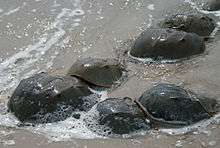
.jpg)
During the breeding season, horseshoe crabs migrate to shallow coastal waters. A male selects a female and clings to her back. Often, several males surround the female and all fertilize together, which makes it easy to spot and count females as they are the large center carapace surrounded by 3-5 smaller ones. The female digs a hole in the sand and lays her eggs while the male(s) fertilize them. The female can lay between 60,000 and 120,000 eggs in batches of a few thousand at a time. In L. polyphemus, the eggs take about two weeks to hatch; shore birds eat many of them before they hatch. The larvae molt six times during the first year and annually after the first 3 or 4 years.[32][33]
Natural breeding of horseshoe crabs in captivity has proven to be difficult. Some evidence indicates that mating takes place only in the presence of the sand or mud in which the horseshoe crab's eggs were hatched. It is not known with certainty what is in the sand that the crabs can sense or how they sense it.[34] Artificial insemination and induced spawning have been done on a relatively large scale in captivity, and eggs and juveniles collected from the wild are often raised to adulthood in captivity.[35][36]
Threats
Harvest for blood
Horseshoe crabs use hemocyanin to carry oxygen through their blood. Because of the copper present in hemocyanin, their blood is blue.[37] Their blood contains amebocytes, which play a similar role to the white blood cells of vertebrates in defending the organism against pathogens. Amebocytes from the blood of L. polyphemus are used to make Limulus amebocyte lysate (LAL), which is used for the detection of bacterial endotoxins in medical applications.[38] There is a high demand for the blood, the harvest of which involves collecting and bleeding the animals, and then releasing them back into the sea. Most of the animals survive the process; mortality is correlated with both the amount of blood extracted from an individual animal, and the stress experienced during handling and transportation.[39] Estimates of mortality rates following blood harvesting vary from 3–15%[40] to 10–30%.[41][42][43] Approximately 500,000 Limulus are harvested annually for this purpose.[44]
Bleeding may also prevent female horseshoe crabs from being able to spawn or decrease the number of eggs they are able to lay. Up to 30% of an individual's blood is removed, according to the biomedical industry, and the horseshoe crabs spend between one and three days away from the ocean before being returned. As long as the gills stay moist, they can survive on land for four days.[45] Some scientists are skeptical that certain companies return their horseshoe crabs to the ocean at all, instead suspecting them of selling the horseshoe crabs as fishing bait.[46]
The harvesting of horseshoe crab blood in the pharmaceutical industry is in decline. In 1986, Kyushu University researchers discovered that the same test could be achieved by using isolated Limulus clotting factor C (rFC), an enzyme found in LAL, as by using LAL itself.[47] Jeak Ling Ding, a National University of Singapore researcher, patented a process for manufacturing rFC; on 8 May 2003, synthetic isolated rFC made via her patented process became available for the first time.[48] Industry at first took little interest in the new product, however, as it was patent-encumbered, not yet approved by regulators, and sold by a single manufacturer, Lonza Group. In 2013, however, Hyglos GmbH also began manufacturing its own rFC product. This, combined with the acceptance of rFC by European regulators, the comparable cost between LAL and rFC, and support from Eli Lilly and Company, which has committed to use rFC in lieu of LAL, is projected to all but end the practice of blood harvesting from horseshoe crabs.[49]
In June 2020, it was reported that U.S. Pharmacopeia had declined to give rFC equal standing with horseshoe crab blood. [50] Without the approval for the classification as an industry standard testing material, U.S. companies will have to overcome the scrutiny of showing that rFC is safe and effective for their desired uses, which may serve as a deterrent for usage of the horseshoe crab blood substitute.[51]
In December 2019, a report of the US Senate which encouraged the Food and Drug Administration to "establish processes for evaluating alternative pyrogenicity tests and report back [to the Senate] on steps taken to increase their use" was released;[52] PETA backed the report.[53]
Fishery
Horseshoe crabs are used as bait to fish for eels (mostly in the United States) and whelk, or conch. However, fishing with horseshoe crab was banned indefinitely in New Jersey in 2008 with a moratorium on harvesting to protect the red knot, a shorebird which eats the crab's eggs.[54] A moratorium was restricted to male crabs in Delaware, and a permanent moratorium is in effect in South Carolina.[55] The eggs are eaten in parts of Southeast Asia, Johor and China.[56]
A low horseshoe crab population in the Delaware Bay is hypothesized to endanger the future of the red knot. Red knots, long-distance migratory shorebirds, feed on the protein-rich eggs during their stopovers on the beaches of New Jersey and Delaware.[57] An effort is ongoing to develop adaptive-management plans to regulate horseshoe crab harvests in the bay in a way that protects migrating shorebirds.[58]
Shoreline development
Development along shorelines is dangerous to horseshoe crab spawning, limiting available space and degrading habitat. Bulkheads can block access to intertidal spawning regions as well.[59]
References
- Lamsdell, James C.; McKenzie, Scott C. (December 2015). "Tachypleus syriacus (Woodward)—a sexually dimorphic Cretaceous crown limulid reveals underestimated horseshoe crab divergence times". Organisms Diversity & Evolution. 15 (4): 681–693. doi:10.1007/s13127-015-0229-3. ISSN 1439-6092.
- Kōichi Sekiguchi (1988). Biology of Horseshoe Crabs. Science House. ISBN 978-4-915572-25-8.
- Stine Vestbo; Matthias Obst; Francisco J. Quevedo Fernandez; Itsara Intanai; Peter Funch (2018). "Present and Potential Future Distributions of Asian Horseshoe Crabs Determine Areas for Conservation". Frontiers in Marine Science. 5 (164): 1–16. doi:10.3389/fmars.2018.00164.
- Smith, D.R.; Beekey, M.A.; Brockmann, H.J.; King, T.L.; Millard, M.J.; Zaldívar-Rae, J.A. (2016). "Limulus polyphemus". IUCN Red List of Threatened Species. IUCN. 2016: e.T11987A80159830. doi:10.2305/IUCN.UK.2016-1.RLTS.T11987A80159830.en. Retrieved 12 March 2019.
- Attaya Kungsuwan; Yuji Nagashima; Tamao Noguchi; et al. (1987). "Tetrodotoxin in the Horseshoe Crab Carcinoscorpius rotundicauda Inhabiting Thailand" (PDF). Nippon Suisan Gakkaishi. 53 (2): 261–266. doi:10.2331/suisan.53.261.
- David Sadava; H. Craig Heller; David M. Hillis; May Berenbaum (2009). Life: the Science of Biology (9th ed.). W. H. Freeman. p. 683. ISBN 978-1-4292-1962-4.
- Ballesteros, J. A.; Sharma, P. P. (14 February 2019). "A Critical Appraisal of the Placement of Xiphosura (Chelicerata) with Account of Known Sources of Phylogenetic Error". Systematic Biology. 68 (6): 896–917. doi:10.1093/sysbio/syz011. PMID 30917194.
- Garwood, Russell J.; Dunlop, Jason A. (13 November 2014). "Three-dimensional reconstruction and the phylogeny of extinct chelicerate orders". PeerJ. 2: e641. doi:10.7717/peerj.641. PMC 4232842. PMID 25405073.
- Clarke JM, Ruedemann R. The Eurypterida of New York.
- Weygoldt P, Paulus HF (1979). "Untersuchungen zur Morphologie, Taxonomie und Phylogenie der Chelicerata". Zeitschrift für zoologische Systematik und Evolutionsforschung. 17 (2): 85–116, 177–200. doi:10.1111/j.1439-0469.1979.tb00694.x.
- Garwood, Russell J.; Dunlop, Jason A.; Knecht, Brian J.; Hegna, Thomas A. (2017). "The phylogeny of fossil whip spiders". BMC Evolutionary Biology. 17 (1): 105. doi:10.1186/s12862-017-0931-1. ISSN 1471-2148. PMC 5399839. PMID 28431496.
- Anatomy: Vision – The Horseshoe Crab
- "Horseshoe Crabs, Limulus polyphemus". MarineBio.org.
- Palumbi, Stephen R.; Palumbi, Anthony R. (23 February 2014). The Extreme Life of the Sea. Princeton University Press. ISBN 9781400849932 – via Google Books.
- "Anatomy: Bottom View". The Horseshoe Crab.
- Silurian horseshoe crab illuminates the evolution of arthropod limbs - NCBI
- "Anatomy: Appendages". The Horseshoe Crab.
- Yaralia Castillo; Laurie A Garabedian (26 April 2007). "Limb Regeneration in Horseshoe Crabs" (PDF). Cite journal requires
|journal=(help) - "The biology of cartilage. I. Invertebrate cartilages:Limulus gill cartilage". ResearchGate.
- Zaldívar-Rae, J.; Sapién-Silva, R.E.; Rosales-Raya, M.; Brockmann, H.J. (2009). "American horseshoe crabs, Limulus polyphemus, in México: open possibilities". In J.T. Tanacredi; M.L. Botton; D.R. Smith (eds.). Biology and Conservation of Horseshoe Crabs. Springer. pp. 97–113. ISBN 9780387899589.
- "About the Species". The Horseshoe Crab. Retrieved 26 June 2018.
- T.C. Srijaya; P.J. Pradeep; S. Mithun; A. Hassan; F. Shaharom; A. Chatterji (2010). "A New Record on the Morphometric Variations in the Populations of Horseshoe Crab (Carcinoscorpius rotundicauda Latreille) Obtained from Two Different Ecological Habitats of Peninsular Malaysia". Our Nature. 8 (1): 204–211. doi:10.3126/on.v8i1.4329.
- Azwarfarid Manca; Faridah Mohamad; Amirrudin Ahmad; Muhd Fawwaz Afham Mohd Sofa; Noraznawati Ismail (2017). "Tri-spine horseshoe crab, Tachypleus tridentatus (L.) in Sabah, Malaysia: the adult body sizes and population estimate". Journal of Asia-Pacific Biodiversity. 10 (3): 355–361. doi:10.1016/j.japb.2017.04.011.
- "Horseshoe Crab (Limulus polyphemus)". WAZA. Archived from the original on 3 July 2017. Retrieved 26 June 2018.
- A. Raman Noor Jawahir; Mohamad Samsur; Mohd L. Shabdin; Khairul-Adha A. Rahim (2017). "Morphometric allometry of horseshoe crab, Tachypleus gigas at west part of Sarawak waters, Borneo, East Malaysia". AACL Bioflux. 10 (1): 18–24.
- Lesley Cartwright-Taylor; Julian Lee; Chia Chi Hsu (2009). "Population structure and breeding pattern of the mangrove horseshoe crab Carcinoscorpius rotundicauda in Singapore" (PDF). Aquatic Biology. 8 (1): 61–69. doi:10.3354/ab00206.
- Manton SM (1977) The Arthropoda: habits, functional morphology, and evolution Page 57, Clarendon Press.
- Shuster CN, Barlow RB and Brockmann HJ (Eds.) (2003) The American Horseshoe Crab Pages 163–164, Harvard University Press. ISBN 9780674011595.
- Vosatka ED (1970). "Observations on the Swimming, Righting, and Burrowing Movements of Young Horseshoe Crabs, Limulus Polyphemus". The Ohio Journal of Science. 70 (5): 276–283. hdl:1811/5558.
- Battelle, B.A. (December 2006), "The eyes of Limulus polyphemus (Xiphosura, Chelicerata) and their afferent and efferent projections.", Arthropod Structure & Development, 35 (4): 261–74, doi:10.1016/j.asd.2006.07.002, PMID 18089075.
- Barlow RB (2009) "Vision in horseshoe crabs" Pages 223–235 in JT Tanacredi, ML Botton and D Smith, Biology and Conservation of Horseshoe Crabs, Springer. ISBN 9780387899589.
- "The Rabbit and the Horse Shoe Crab". September 23, 2014. Retrieved 2016-12-20.
- "Molt". The Horseshoe Crab.
- David Funkhouser (April 15, 2011). "Crab love nest". Scientific American. 304 (4): 29. doi:10.1038/scientificamerican0411-29.
- Yan Chen; C. W. Lau; S. G. Cheung; C. H. Ke; Paul K. S. Shin (2010). "Enhanced growth of juvenile Tachypleus tridentatus (Chelicerata: Xiphosura) in the laboratory: a step towards population restocking for conservation of the species". Aquatic Biology. 11: 37–40. doi:10.3354/ab00289.
- Ruth H. Carmichael; Erik Brush (2012). "Three decades of horseshoe crab rearing: A review of conditions for captive growth and survival". Reviews in Aquaculture. 4 (1): 32–43. doi:10.1111/j.1753-5131.2012.01059.x.
- "Anxious Arthropods". Ohio History Org. 2014-09-25. Archived from the original on 2020-03-29. Retrieved 2020-03-29.
- "The horseshoe crab and public health". HorseshoeCrab.org.
- Lenka Hurton (2003). Reducing post-bleeding mortality of horseshoe crabs (Limulus polyphemus) used in the biomedical industry (PDF) (M.Sc. thesis). Virginia Polytechnic Institute and State University. Archived from the original (PDF) on 2013-06-22. Retrieved 2011-04-18.
- "Crash: A Tale of Two Species – The Benefits of Blue Blood – Nature – PBS". 10 June 2008.
- The Blood Harvest The Atlantic, 2014.
- Carmichael, R.H.; Shin, M.L.; Cheung, S.G. (Eds.) (2015). Changing Global Perspectives on Horseshoe Crab Biology, Conservation and Management. Springer International Publishing.CS1 maint: extra text: authors list (link)
- Chesler, Caren. "Medical Labs May Be Killing Horseshoe Crabs". Scientific American. Scientific American. Retrieved 10 May 2018.
- Chesler, Caren. "The Blood of the Crab". Popular Mechanics (13 April 2017). Retrieved 16 April 2017.
- The Horseshoe Crab - US Fish and Wildlife Service
- Chesler, Caren (June 9, 2016). "Medical Labs May Be Killing Horseshoe Crabs". Scientific American. Retrieved 2017-11-03.
- Iwanaga, Sadaaki; Morita, Takashi; Miyata, Toshiyuki; Nakamura, Takanori; Aketagawa, Jun (1986-08-01). "The hemolymph coagulation system in invertebrate animals". Journal of Protein Chemistry. 5 (4): 255–268. doi:10.1007/bf01025424. ISSN 0277-8033.
- "PyroGene : Licensing Success". National University of Singapore. 8 May 2003. Retrieved 2018-09-01.
- Zhang, Sarah (2018-05-09). "The Last Days of the Blue-Blood Harvest". The Atlantic. Retrieved 2018-09-01.
- Fox, Alex. "The Race for a Coronavirus Vaccine Runs on Horseshoe Crab Blood". Smithsonian Magazine. Retrieved 2020-06-09.
- "Drugs standards group nixes plan to kick pharma's crab blood habit". Reuters. 2020-05-30. Retrieved 2020-06-09.
- "S. Rept. 116-110 - AGRICULTURE, RURAL DEVELOPMENT, FOOD AND DRUG ADMINISTRATION, AND RELATED AGENCIES APPROPRIATIONS BILL, 2020". United States Congress. Retrieved 2020-01-18.
- "PETA Statement: U.S. Spending Bill". PETA. 2019-12-20. Retrieved 2020-01-18.
- "N.J. law protects horseshoe crabs". UPI. 25 March 2008. Retrieved 27 July 2018.
- "Horseshoe crab". SC DNR species gallery. Archived from the original on March 31, 2016. Retrieved 2011-06-06.
- 大西一實. "Vol.56 食うか食われるか?". あくあは〜つ通信. Archived from the original on 2003-08-13. Retrieved 2008-04-18.
- "Red knots get to feast on horseshoe crab eggs". Environment News Service. March 26, 2008. Retrieved 2011-01-19.
- "Critter Class Hodge Podge (Horseshoe crabs and Wooly Bears)" (PDF). The Wildlife Center. October 26, 2011. Retrieved 2015-03-09.
- "Conservation". ERDG. Retrieved 2016-05-19.
Further reading

External links
| Wikimedia Commons has media related to Limulidae. |
- LAL Update
- Science Friday Video: horseshoe crab season
- Horseshoe crab at the Smithsonian Ocean Portal
- The Horseshoe Crab – Medical Uses; The Ecological Research & Development Group (ERDG)
- RedKnot.org links to shorebird recovery sites, movies, events & other info on Red Knot rufa & horseshoe crabs.
- Crab Bleeders Article about the men who bleed horseshoe crabs for science.
- Day time mating of horseshoe crabs in Maine
- Sarah Zhang, The Last Days of the Blue-Blood Harvest, The Atlantic, May 9, 2018
